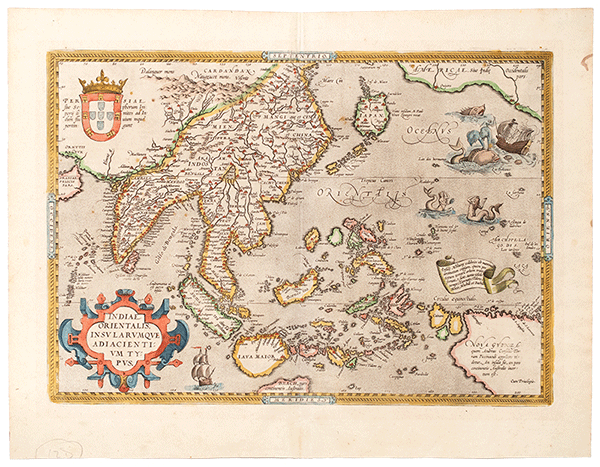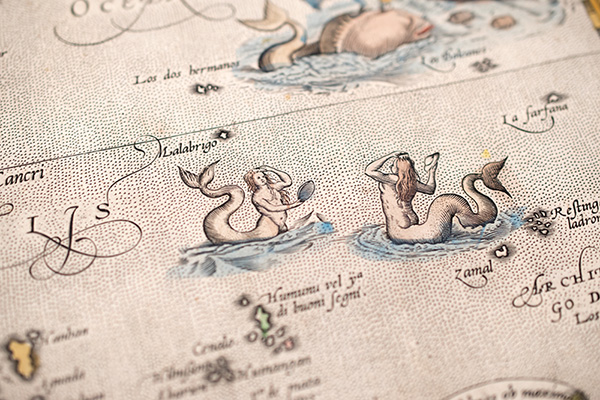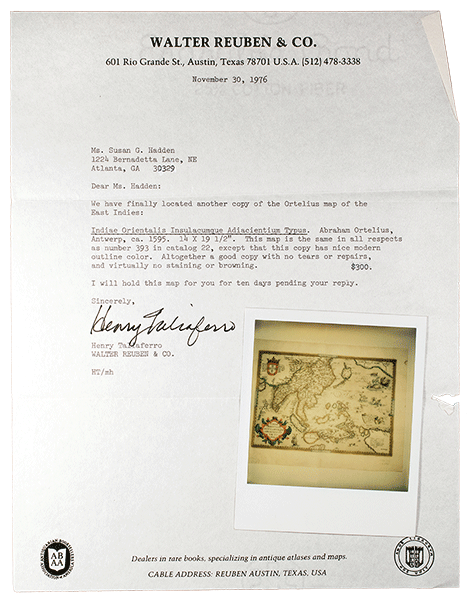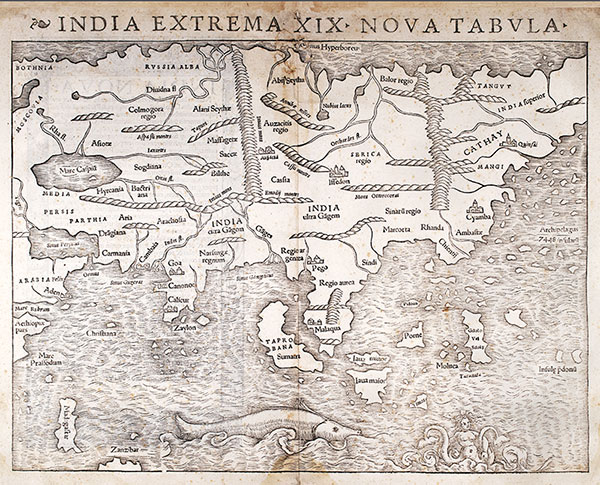Charting a Path
Sixty maps and other prints of South Asia and the surrounding region have recently arrived at the Ransom Center at The University of Texas at Austin in honor of former professor Susan G. Hadden. Generously donated by her husband, James Hadden, Jr., the newly acquired Susan G. Hadden Collection of Early Maps of India contains maps dating from 1540 to around 1880, and together they track developments in cartography and the rise of European trade, colonization, and ultimately empire in the region.
The Hadden collection’s earliest map is a two-page woodcut that was printed as part of Sebastian Münster’s Geographia (Basel, 1540), a Latin version of Ptolemy’s widely printed and adapted Geography. It is the first printed map dedicated to illustrating the Asian continent as a whole. In it, only four cities within India have been identified, all on the western coast, all sites of early Portuguese settlement and/or trade.
One of the most significant maps in the collection was first published only 30 years later: a copy of Abraham Ortelius’s map of Southeast Asia from a later sixteenth- or early seventeenth-century edition of his Theatrum orbis terrarum, the book famously recognized as the first modern atlas. Printed from an engraved copperplate, Ortelius’s map stands in contrast to Münster’s, naming dozens of ports along the full coast of the Indian peninsula along with numerous cities in the interior.

The maps’ collector, Susan G. Hadden (1945–1995), was born in Austin, Texas. Not long after her birth, her family moved across the country when her father, Nathan Ginsburg, took a faculty position in physics at Syracuse University. Once grown, Hadden obtained degrees from Radcliffe College and the University of Chicago, ending up back in Austin as a professor in the LBJ School of Public Affairs and the Center of Asian Studies at The University of Texas. She worked at the university from 1979 until her death.

When Hadden was approaching the end of her time as a doctoral student, her parents took an extended vacation in Europe. While traveling, they purchased maps to give their daughter as a present when she finished her degree. Hadden went on to build a significant map collection, using what she had amassed to decorate her home and, once in Austin, her office.
The articles, catalog clippings, purchase receipts, and correspondence with map dealers that accompany the collection show Hadden’s diligence in learning about maps—and acquiring them—from the early 1970s and into the early 1980s. A 1977 letter from a bookseller appears to indicate that Hadden at one time hoped to compile a bibliography describing every published map of India.

A letter from the previous year reveals that Hadden initially missed out on a copy of the Ortelius map mentioned above, one that had been on offer from the Austin-based bookseller Walter Reuben and Company. In a letter to Hadden, Reuben associate Henry Taliaferro writes, “We have finally located another copy of the Ortelius map of the East Indies,” offering it to her for $300. An off-center and somewhat blurry Polaroid photo of the map accompanies the letter, and two follow-up receipts—and, of course, the map itself—show that Hadden followed through with the purchase. One receipt suggests that she had been so eager to secure an Ortelius from Reuben that she put down a $100 deposit to ensure that she was offered the next one to become available.

Dr. Aaron T. Pratt is the Carl and Lily Pforzheimer Curator of Early Books and Manuscripts at the Ransom Center.
Image: John Rapkin, British India [map], in The Illustrated Atlas, and Modern History of the World, ed. Robert Montgomery Martin (London: John Tallis and Company, ca. 1851). Susan G. Hadden Collection of Early Maps of India, Harry Ransom Center.

